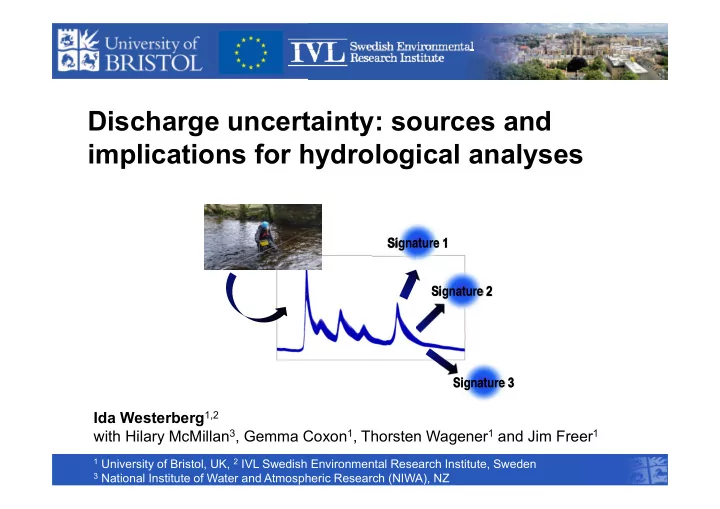

Discharge uncertainty: sources and implications for hydrological analyses Signature 1 Signature 1 Signature 2 Signature 2 http://comm ons.wikime dia.org/wiki/ File:Piasnic a- Signature 3 Signature 3 wodowskaz -0.jpg Ida Westerberg 1,2 with Hilary McMillan 3 , Gemma Coxon 1 , Thorsten Wagener 1 and Jim Freer 1 1 University of Bristol, UK, 2 IVL Swedish Environmental Research Institute, Sweden 3 National Institute of Water and Atmospheric Research (NIWA), NZ
Why Study Discharge Uncertainty? Uncertainties in discharge data reduce their information content for hydrological analyses – and the reliability of the knowledge we infer from these analyses Signature 1 Signature 1 Signature 2 Signature 2
Overview Sources of discharge uncertainty Rating-curve uncertainty estimation for 43 UK catchments mplications of rating-curve uncertainty for uncertainty in hydrological signatures (i.e. flow ndices)
Discharge Measurement ischarge derived from stage using a rating curve at most stations orldwide he rating curve is fitted to gaugings of stage and discharge 10 Discharge (m 3 /s) 8 6 4 2 0 0 0.2 0.4 0.6 0.8 Stage (m)
Discharge Uncertainty Sources auging measurement uncertainty eatory) ating curve approximation of true age-discharge relation (epistemic) Extrapolation to ungauged flow conditions Variable backwater and hysteresis Seasonal weed growth, erosion/sedimentation ontinuous measurement of water level me series
Rating Curve Uncertainty Sources High flows - Extrapolation High flows - Hysteresis?
Rating Curve Uncertainty Sources Earlier rating Low flows - seasonal weed growth www.ceh.ac.uk/data/nrfa/data/station.html?52010 High flows – Backwater?
How to estimate the uncertainty? • Epistemic uncertainty about information content in gauging data: • Which points are outliers and which points have information about the stage-discharge relation? • How has the stage-discharge relation varied in time?
Discharge Uncertainty Estimation certainty Sources Uncertainty Estimation Sample multiple rating curves in Monte ting curve approximation of e stage-discharge relation Carlo analysis pistemic uncertainty => all Let gauging points “vote” for each curve uged points may not be using Voting Point likelihood mpatible with one rating curve) Based on official rating curve form Aims to represent total uncertainty (aleatory and epistemic) McMillan & Westerberg, HP 2015
Rating curve uncertainty for 43 UK catchments ata Rating curves with corresponding gauging data 15-minute water levels for 2003–2008 43 catchments classified as having a natural flow regime 140 Signatures calculated at the hourly time scale 90 Comparable to 80 120 historic rating 70 100 Discharge (m 3 /s) variability Percentile (%) 60 (stable site) 80 50 Official rating 60 40 2003-2008 30 40 20 20 10 0 0.2 0.4 0.6 0.8 1 1.2 1.4 1.6 1.8
Rating curve and signature uncertainty Flow percentiles Low flows High flows Signature uncertainty = combination of rating curve uncertainty & flow series variability
Flow percentiles
Flow percentiles
Flow percentiles
Gauged signature uncertainty Slope of FDC Uncertainty can obscure interpretation of differences between catchments Mean flow Relative uncertainty
Relative uncertainty magnitudes (halfwidths of 5- 95 percentile ranges) Factors affecting Uncertainty Signatures uncertainty Low: ± 10% Large gauging scatter for whole Average flow , Medium: ± 12-15% flow range, or range contributing conditions 0 most of total flow volume. High: ± 30-40% Low: ± 15-20% Scatter in low flow gaugings Low flows Medium: ± 30-40% (e.g. weed growth or riverbed erosion) High: ± 70-90% Low: ± 10-15% High flow uncertainty. High flows Medium: ± 20-30% Extrapolation and/or scatter in high flow gaugings High: ± 30 60%
Discussion - Rating curve and discharge uncertainty Place-specific variability with flow range Causes systematic uncertainty in discharge data Small rivers with large flow variability and fast rainfall-runoff response impedes reliable gauging Voting Point likelihood method – generating multiple feasible rating curve samples allows assessment of uncertainty impact on any subsequent analysis Uncertainty estimations for a wide range of multi-section rating curves and different error sources Aimed to be a practical method (no detailed hydraulic information about stations) Important to check estimations against available metadata (e.g. to avoid unreliable out-of-bank extrapolation)
Discussion – Impacts on signature uncertainty Signature uncertainty = combination of rating curve uncertainty & flow series variability Largest uncertainty for signatures describing high/low flow magnitude and dynamics (medium level ±30-40%) Lowest for average flow conditions (medium level ±12-15%) Important implications for cross-catchment comparisons, model calibration, trend analyses, flood/drought studies and nutrient load estimation Understanding rating curve uncertainty is key to understanding discharge data information content Are some flows extrapolated or out of bank? Has the station and rating curve uncertainties changed with time?
Questions? nowledgements his research was funded by a Marie Curie Intra European Fellowship within the 7th uropean Community Framework Programme ream discharge stage data and rating curve information has been supplied by the
Recommend
More recommend